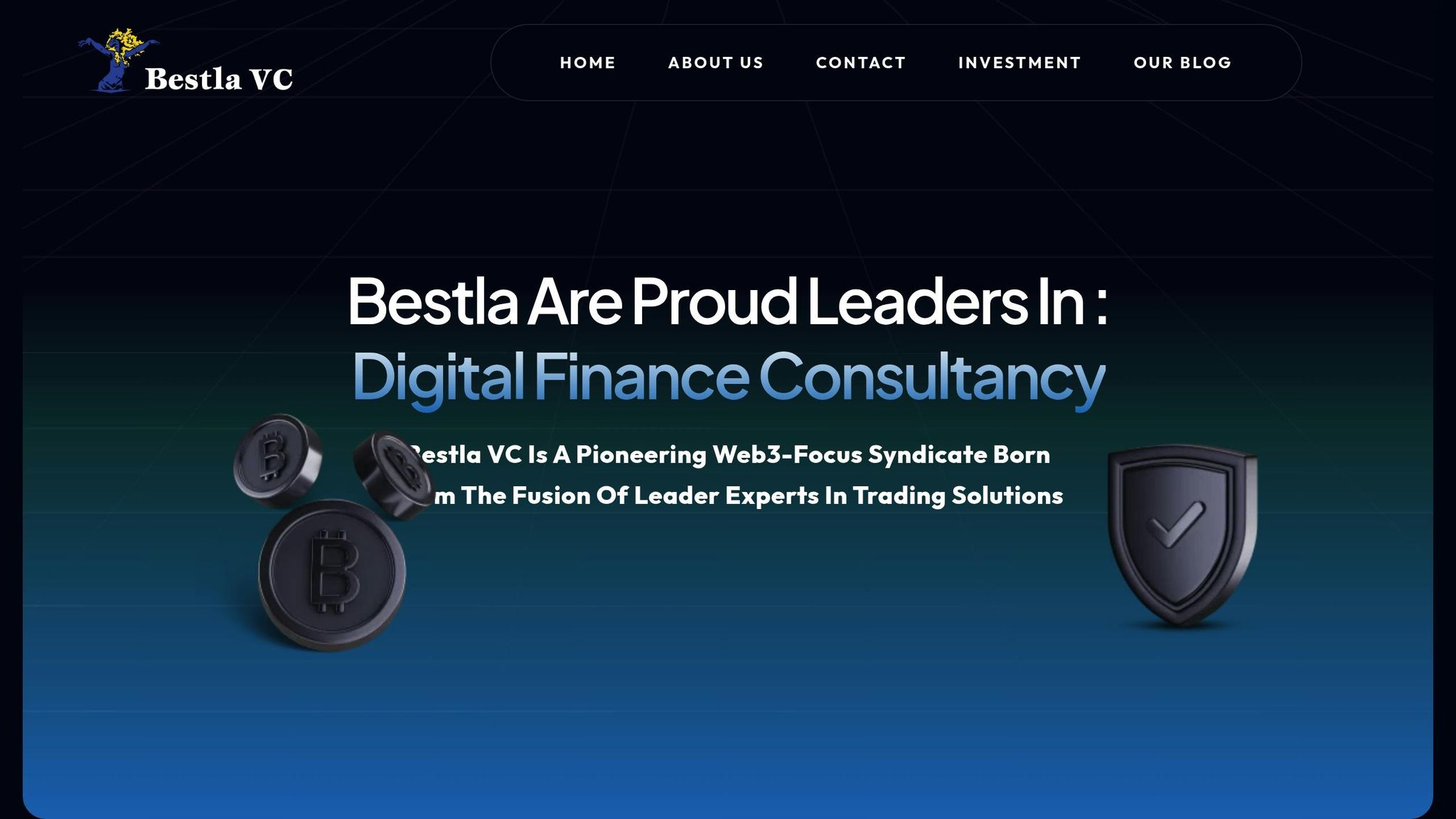Institutions are reshaping digital asset investments with secure infrastructure, diversified portfolios, and AI-powered tools. Here’s what you need to know:
-
Core Strategies:
- Build secure connections between traditional and decentralized systems.
- Focus on key areas like AI-Web3 integration, financial infrastructure, and the Bitcoin ecosystem.
- Manage risks through compliance, custody solutions, and advanced trading systems.
-
Revenue Generation:
- Earn through staking, validator operations, and DeFi strategies like lending and liquidity provision.
-
Portfolio Diversification:
- Mix digital assets (Layer 1 networks, DeFi protocols) with traditional investments, using AI for optimization.
-
Future Trends:
- Expect more enterprise adoption, evolving regulatory frameworks, and AI-driven portfolio management.
Institutions are blending traditional finance with blockchain innovations to create sustainable, secure, and diversified investment strategies.
2025 and Beyond: Crypto Asset Opportunities for Institutional …
Key Elements of Institutional Portfolio Management
Institutional investors need strong systems to effectively manage digital asset portfolios. These systems must prioritize regulatory adherence and secure asset management practices.
Meeting Compliance Requirements
Regulatory compliance is the cornerstone of managing digital asset portfolios for institutions. Organizations must adopt risk management strategies that align with changing regulatory standards.
Here are the primary areas of compliance:
| Requirement Area | Key Components | Implementation Focus |
|---|---|---|
| Legal Structure | International legal frameworks | Jurisdiction-specific compliance |
| Risk Management | Counterparty risk protocols | Ongoing risk monitoring |
| Trading Controls | Algorithmic trading systems | Efficient market access |
| Asset Security | Multi-signature protocols | Custody solution integration |
| Audit Trail | Transaction monitoring | Regulatory reporting |
Once compliance is addressed, the focus shifts to secure storage and reliable market access to ensure operational stability.
Asset Storage and Market Access
After meeting compliance standards, institutions prioritize secure asset custody and effective market access. Together, these elements form the backbone of institutional portfolio management.
Custody Solutions
Institutional custody requires robust security measures, including:
- Cold Storage: Offline storage using multi-signature protocols to ensure maximum security.
- Hot Wallets: Online accounts equipped with automated risk controls for active trading.
- Backup Systems: Distributed recovery mechanisms across multiple geographic locations.
Market Access Strategy
Efficient trading and position management are critical for institutional market operations.
-
Trading Infrastructure
Advanced algorithmic trading systems help institutions:- Execute large trades with minimal market disruption.
- Maintain liquidity for treasury operations.
- Automate portfolio rebalancing for efficiency.
-
Secondary Market Integration
Regulated secondary markets offer key advantages, such as:- Access to high-quality investment opportunities.
- Enhanced privacy for transactions.
- Lower exposure to counterparty risks.
-
Liquidity Management
Effective liquidity management includes:- Connecting to multiple trading venues.
- Monitoring positions in real time.
- Using automated risk controls to safeguard trades.
Portfolio Diversification Methods
Institutions are now focusing on diversifying their portfolios to reduce risk, building on secure custody and efficient trading practices. This involves strategically allocating investments across assets that don’t move in sync and adapting to changing market trends.
Digital Asset Class Distribution
Investments are spread across major categories like Layer 1 networks, stablecoins, DeFi protocols, tokenized assets, and infrastructure assets. Each category is selected based on its unique market behavior and risk characteristics. The rise of Decentralized Physical Infrastructure Networks (DePIN) is also opening up new possibilities by connecting digital assets with physical infrastructure.
Mixed Portfolio Construction
Institutions are combining digital assets with traditional financial instruments to create balanced portfolios. This is made possible through advanced technology platforms. Key factors include:
- Technology Integration: Leveraging cross-system bridges and AI-powered tools to allocate resources effectively while using automated systems to track market trends.
- Risk Management: Evaluating how different markets interact, ensuring compliance across multiple jurisdictions, and maintaining liquidity across various assets.
- Market Access: Engaging with regulated trading venues, improving trade execution, and ensuring smooth operations.
The combination of AI and Web3 technologies allows for more sophisticated portfolio management. These tools enable real-time market analysis and automated adjustments, making it easier to refine diversification strategies and explore new revenue opportunities in digital asset portfolios.
sbb-itb-c5fef17
Revenue Generation Techniques
Institutional investors are moving beyond simple buy-and-hold strategies, leveraging advanced methods to earn consistent returns from digital asset holdings. These approaches focus on earning income through blockchain network participation and decentralized finance (DeFi) mechanisms.
Network Participation Income
Participating in blockchain networks has become a key way for institutions to generate revenue. By committing assets to these networks, they can earn rewards through staking and validation activities.
Some main strategies include:
- Liquid Staking: This involves staking assets while receiving derivative tokens, which maintain liquidity. It allows institutions to support network security and simultaneously explore other yield opportunities.
- Validator Operations: Operating validator nodes on proof-of-stake networks is a reliable way to earn consistent returns.
- Delegation Services: Larger institutions often offer staking-as-a-service, managing staking for smaller participants in exchange for a share of the rewards.
These activities form the foundation of institutional revenue generation. However, DeFi protocols offer additional opportunities to enhance returns.
DeFi Income Opportunities
DeFi platforms provide various ways to earn income, such as lending and liquidity provision. While these methods can be profitable, they require careful risk assessment.
Key DeFi strategies include:
- Liquidity Provision: Institutions can earn fees by contributing assets to decentralized exchanges and automated market makers. However, they must account for risks like impermanent loss.
- Strategic Lending: Overcollateralized lending allows institutions to earn interest income, though it’s important to manage risks related to fluctuating interest rates and collateral values.
- Yield Aggregation: Smart contract systems can automatically distribute assets across multiple protocols to maximize returns.
New Developments in Asset Management
Institutional digital asset management is evolving rapidly with advanced tools and a more mature market landscape. These changes are reshaping how portfolios are managed and how institutions access markets, introducing better trading systems and tokenization opportunities.
Upgrades in Investment Tools
Platforms are now merging traditional finance with digital assets, offering more secure and sophisticated trading systems. These improvements go hand-in-hand with the compliance and risk management protocols previously discussed.
- Advanced Trading Platforms: Algorithmic trading systems in the spot market are enabling institutions to access tighter spreads and manage varying trading volumes more effectively.
- Privacy-Focused Marketplaces: Regulated trading venues are implementing stronger privacy measures, making it easier to access high-tier digital asset projects while reducing counterparty risks.
- Integrated Legal Frameworks: Investment platforms now include legal structures tailored for Web3 projects, simplifying compliance with regulatory requirements.
In addition to these trading enhancements, the rise of asset tokenization is creating new opportunities for portfolio diversification.
Progress in Asset Tokenization
Tokenizing traditional assets is becoming a key strategy for diversifying portfolios. This trend aligns with the long-term diversification strategies mentioned earlier.
- Infrastructure Expansion: Bridges between traditional and decentralized finance are enabling smoother asset conversions and value transfers across markets.
- Physical Asset Connections: Decentralized physical infrastructures are being integrated to link liquidity between traditional and digital assets.
- AI-Driven Management: Artificial intelligence tools are now being used to optimize portfolio allocation and manage risks across both traditional and digital asset classes.
These developments are particularly evident within the Bitcoin ecosystem, where institutional interest continues to grow. Financial service providers are leveraging these advancements to deliver more comprehensive digital asset management solutions for their institutional clients.
Bestla VC‘s Investment Approach

Investment Focus Areas
Bestla VC zeroes in on institutional digital assets, blending AI with Web3 technologies. By leveraging artificial intelligence, the firm enhances portfolio management and market analysis. Another critical area is decentralized physical infrastructure networks, which connect traditional and digital financial systems.
The firm also prioritizes practical applications within the Bitcoin ecosystem, supporting projects that align blockchain advancements with institutional requirements. Key areas of focus include:
| Focus Area | Strategic Emphasis | Market Impact |
|---|---|---|
| AI-Web3 Integration | Improves portfolio analytics | Better decision-making |
| Infrastructure Development | Bridges traditional and open finance | Broader market access |
| Bitcoin Ecosystem | Offers institutional-grade exposure | Direct asset integration |
| DePIN Solutions | Links real-world assets | Connects physical and digital assets |
These priorities feed directly into Bestla VC’s approach to market access.
Institutional Market Access
Bestla VC simplifies institutional entry into digital asset markets, prioritizing security and compliance. Its OTC investment model employs global algorithmic trading in spot markets, ensuring efficient execution and competitive spreads.
Additionally, the firm offers treasury management solutions to access Tier 1 projects while maintaining privacy and reducing counterparty risk. Custom legal frameworks are designed to navigate complex regulatory landscapes.
Thanks to its multidisciplinary team – spanning law, mathematics, physics, computer science, blockchain consulting, and digital asset management – Bestla VC delivers tailored solutions for institutions navigating the digital asset space.
Conclusion
Key Strategy Summary
Institutional approaches to digital asset management are becoming more advanced, with a strong focus on portfolio management. Combining AI-driven analytics with traditional investment methods has become a key factor for success. Institutions that pair secure custody solutions with diverse revenue sources often achieve better risk-adjusted returns.
The most effective strategies are built around three main pillars:
| Strategic Pillar | Implementation Focus | Market Impact |
|---|---|---|
| Infrastructure | Custody and market access | Lower operational risks |
| Portfolio Construction | Multi-asset exposure | Better risk-adjusted returns |
| Revenue Generation | Network and DeFi yields | Steady income streams |
These pillars reflect the changing dynamics in the digital asset market.
Future Market Outlook
The market is poised for major changes as these strategies evolve. The combination of AI and Web3 technologies is revolutionizing portfolio management, while decentralized physical infrastructure networks (DePIN) are opening up fresh investment opportunities by connecting digital assets with real-world infrastructure.
Three major trends are likely to shape the future of institutional investments:
- Enterprise Adoption: Leading financial institutions are rapidly incorporating digital asset services, focusing on areas like custody and trading infrastructure.
- Regulatory Framework Evolution: As compliance frameworks mature, more institutions are engaging with regulated DeFi protocols.
- Technology Integration: Innovations in cryptography and AI analytics are improving risk management and portfolio optimization.
These developments indicate a move toward more advanced investment tools and easier access to top-tier projects. At the same time, institutions are prioritizing high levels of security and compliance. The growing overlap between traditional financial systems and decentralized platforms is paving the way for new opportunities in institutional capital investments.


